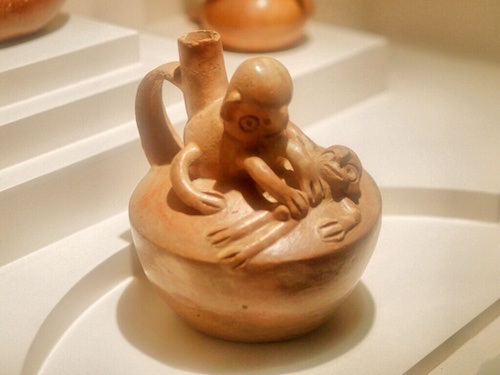
The Salinar culture (200 B.C.-200 A.D.) that reigned on the north coast of Peru meant a short transition period between the Cupisnique and the Moche cultures. Continuity can be seen in ceramics, especially. Socially, the Salinar period was unsettled. Old fields were abandoned, fortified refuges were built and the size of population centers was increased in the hope of security provided by mass power. It has been said that the reason for the unrest of the era was the end of easily-cultivated land, when a strife over land would have led to confrontation. The Salinar ceramics largely carries on the traditions of the Cupinisque ceramics. What is missing from the Salinar vessels, however, is the artistic elegance of the Cupinisque ceramics. It has been replaced by fresh directness. The sculptural decorative motifs of the Salinar ceramics were animals and people, and one of its new areas was erotic ceramics. In addition to sculptural vessels, also plainer paint-ornamented vessels were made within the culture. The typical ground color of the Salinar ceramics changes from orange to beige.




Around 200 BC the Early Horizon with its central trait, the unifying Chavín ideology, came to an end. On the north coast the attempt by threatened local rulers to retrench their ideological justification on transcendent religion rather than principles of local kinship, after being temporarily successful, finally failed and Chavín influence in portable art as manifested by the Cupisnique Style disappeared from the archaeological record. In the succeeding Early Intermediate Period (ca. 200 BCE – 600 AD) the north coast experienced an initial transitional period of disruption followed by consolidation and full florescence of regional civilization in the Moche archaeological culture. The Salinar and Gallinazo (Virú) “cultures” of this period were in all probability expressions of north coast population. There is almost no indication that there may have been population replacement at this time and the material culture of the two cultural groups shares many features drawn from the coastal tradition. The Salinar Period was characterized by several features that suggests that social disruption and political unrest accompanied the end of the Early (Chavín) Horizon.
References:
Salinas Culture: http://www.tampere.fi/ekstrat/taidemuseo/arkisto/peru/800/salinar_en.htm
End of Chavin Culture: http://www.unm.edu/~gbawden/324-MochOrigins/324-MochOrigins.htm

